
We investigate our suspicions concerning a vertical and horizontal cheeseburger conspiracy theory.
On October 21, McDonald’s Japan brought back a lineup of popular burgers which are also well-known for their commercials starring Japanese singer-actor heartthrob Kimutaku (who noticeably holds his burgers in a very strange way). These three limited-time releases are the spicy double cheeseburger, the hami double cheeseburger (hami is short for hamideru, which means “sticking out” or “protruding”), and the triple cheeseburger.
▼ A Kimutaku commercial highlighting the triple cheeseburger
ブッチぎりで #トリチ 🍔⏫
— マクドナルド (@McDonaldsJapan) October 28, 2020
木村拓哉さんも「ダブチじゃない」と言ってしまうほどボリューミーなトリチが待望の復活😁
ダブチ好きなら絶対に食べておきたいバーガーです👍#ヤベェよダブチhttps://t.co/TDCe4Hzkwa pic.twitter.com/LRkZunwqsy
Our story today transpired when our Japanese-language reporter Tasuku Egawa was practicing the Kimutaku-style of holding a burger in front of his local McDonald’s. He happened to take a closer look at the poster advertisement for the lineup and the seeds of distrust began to grow in his mind. Could it be that the hami double cheeseburger and the triple cheeseburger are ultimately the same?
Directly below Kimutaku’s face in the ad were large photos of each of the burgers. To Tasuku’s eyes, apart from the number and size of the patties, they appeared the same. There was nothing else to do but investigate further.
▼ Hami double cheeseburger (top and triple cheeseburger (bottom)
Each of the burger descriptions were as follows on the official McDonald’s Japan website:
Hami double cheeseburger: Features two juicy beef patties that are 1.3 times larger* than usual and protrude outside of the buns (*prior to cooking)
Triple cheeseburger: Features three 100-percent beef patties with no thickeners along with three robust slices of cheddar cheese
The major differences between them were supposedly that the hami double cheeseburger patties were larger than usual and that there were three patties in the triple cheeseburger. To add further fuel to the fire, they were both priced at 420 yen (US$4.00). Maybe it was just a visual trick of stacking the normal-sized patties vertically and laying the larger patties out horizontally, but did they actually contain the same amount of beef in the end…?!
▼ Kimutaku doesn’t seem to notice that anything suspicious is going on.
Tasuku quickly procured one of each burger and pulled out his kitchen scale to begin his experimenting.
▼ Hami double cheeseburger (left) and triple cheeseburger (right)
The hami double cheeseburger clocked in at 193 grams (6.81 ounces). In contrast, the triple cheeseburger was 213 grams. Tasuku had been certain that they would be almost exactly the same weight, so this came as a bit of a surprise–especially since they cost the same amount of money. So far, it appeared that the triple cheeseburger edged out the hami double cheeseburger in terms of cost-effectiveness.
He could have concluded his investigation then but he still had some nagging questions. For instance, was the 20-gram difference in weight a result of the meat or the addition of an extra slice of cheese? Upon disassembling the burgers it was clear that the two hami double cheeseburger patties were indeed bigger than usual. For condiments they had cheese, pickles, onions, and ketchup.
On the other hand, the triple cheeseburger had three patties and one slice of cheese more than the hami double cheeseburger. The condiments were exactly the same as on the other burger.
He decided to weigh the meat by itself out of curiosity, so he scraped off as much of the cheese and other condiments as he could from all of the patties.
Although there was still a tiny amount of cheese clinging to the beef that he wasn’t able to remove, the results showed that in comparison to the hami double cheeseburger’s 104 grams of total beef, the triple cheeseburger contained 111 grams of beef. It was a very subtle difference, but the triple cheeseburger’s patties were ultimately heavier.
However, at the same time, there was also more cheese that he couldn’t entirely scrape away clinging to the triple cheeseburger’s three patties. For some reason the amount of cheese that couldn’t be scraped away seemed proportional to the area where the patties and the cheese were touching, and that space was of course greater in the case of the triple cheeseburger. Moreover, it was only a mere seven grams in difference.
The triple cheeseburger was still 20 grams heavier in the end, though. As a further test, he decided to weigh the bottommost buns along with the cheese, pickles, onions, and ketchup. That came out to be 50 grams for the hami double cheeseburger and 66 grams for the triple cheeseburger. Setting aside the condiments, it was clear that the difference was due to the amount of cheese used in each.
The weight difference in cheese seemed amplified because of the portions that wouldn’t easily peel off from the uppermost buns or that clung to the knife. In addition, when comparing the collected cheese and other condiments, the biggest difference appeared to stem from the addition or absence of one slice of cheese. He consequently thought that there was indeed a strong possibility that the amount of the meat was virtually the same.
In the end, Tasuku admitted that his original suspicions that the two burgers were almost exactly the same weren’t quite on target. As far as the measurement results are concerned, the total amount of the meat used in each did seem to be almost equal, though. The amount of cheese on the triple cheeseburger was unmistakably greater and that seemed to be the determining factor for its greater weight.
Their cost was exactly the same. The amount of the meat was almost exactly the same. In terms of weight and the amount of cheese, the triple cheeseburger won, making it slightly more cost effective. Come to think of it, the catchphrase for the triple cheeseburger was “Breaking away from the other competition.” Perhaps the answer had been hiding in those words all along. In any case, there were bound to be people who preferred one over the other–Tasuku guessed that it all had to do with how big of a cheese fan they were.
Sources: McDonald’s Japan, Twitter/McDonaldsJapan
Images: SoraNews24
● Want to hear about SoraNews24’s latest articles as soon as they’re published? Follow us on Facebook and Twitter!
[ Read in Japanese ]

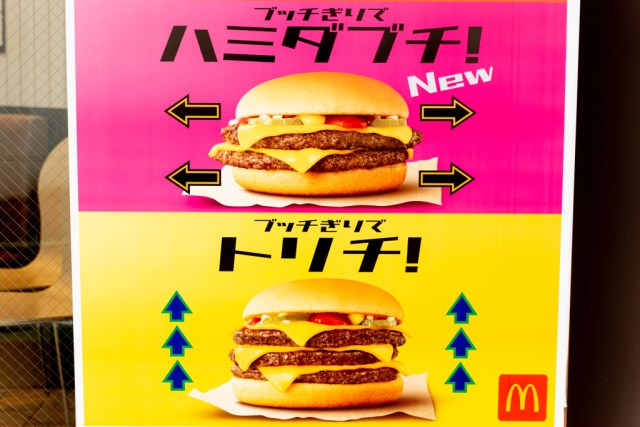

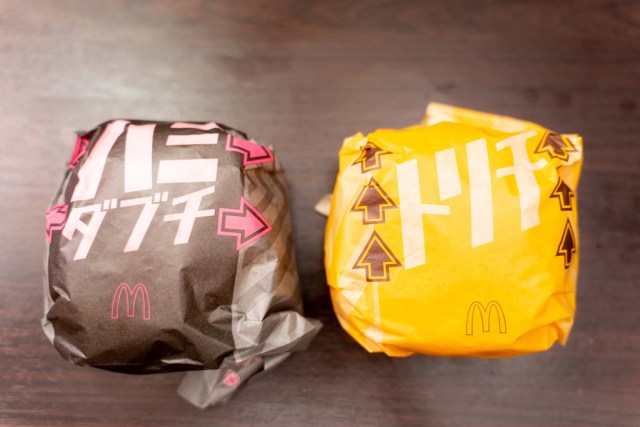
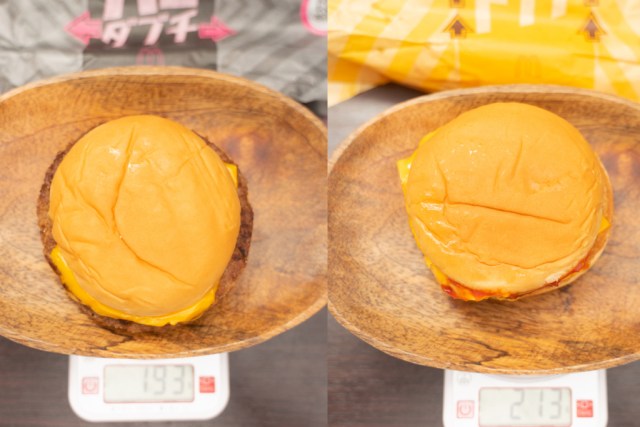
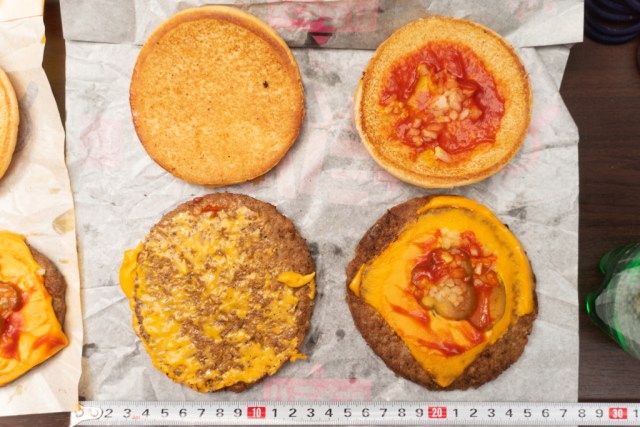
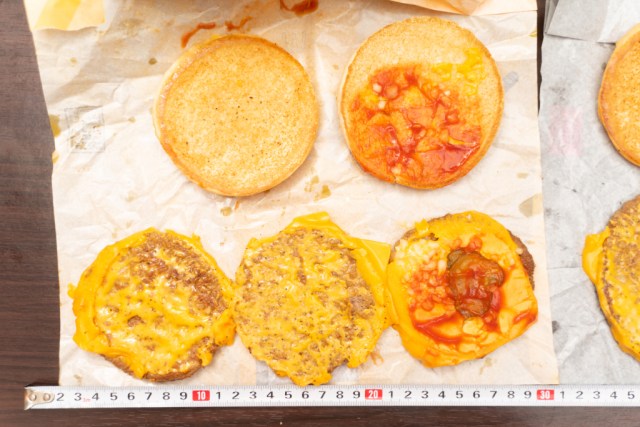
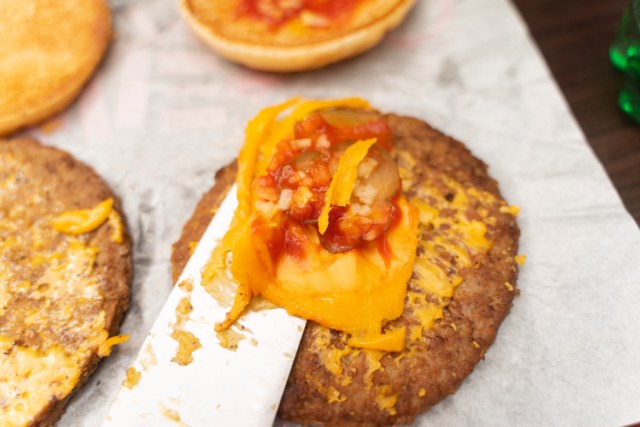
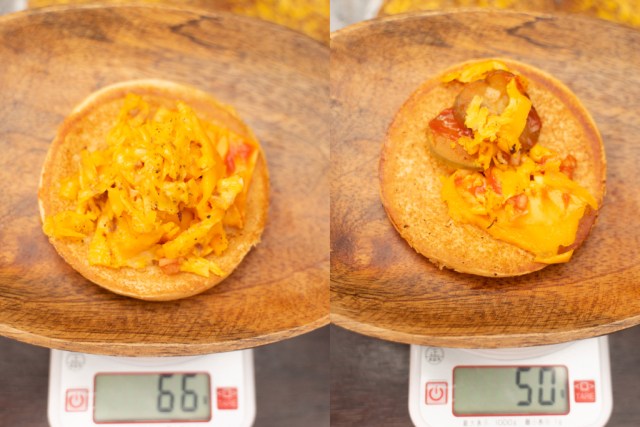
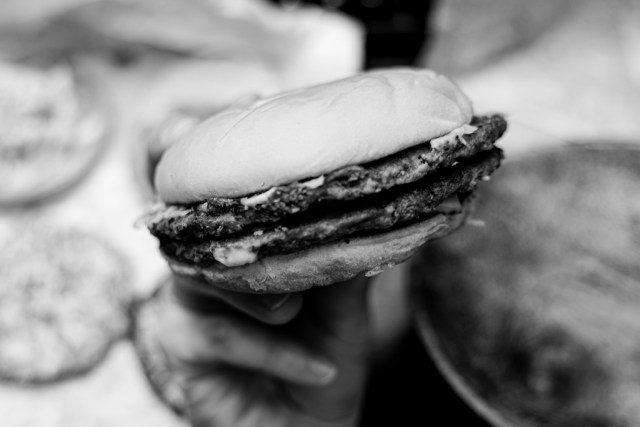
 Burger King Japan’s Cheeseburger Gelände — exceptional in taste, size and… paper napkins?
Burger King Japan’s Cheeseburger Gelände — exceptional in taste, size and… paper napkins? McDonald’s Japan’s Samurai Mac series: which burger is the greatest warrior of all?
McDonald’s Japan’s Samurai Mac series: which burger is the greatest warrior of all? Japan super budget dining – What’s the best way to spend 1,000 yen at McDonald’s?
Japan super budget dining – What’s the best way to spend 1,000 yen at McDonald’s? Burger King’s new all-cheese The Real Cheese Burger looks crazy, sort of makes linguistic sense
Burger King’s new all-cheese The Real Cheese Burger looks crazy, sort of makes linguistic sense Burger King Japan unleashes King Yeti the One Pounder and all of its cheesy goodness
Burger King Japan unleashes King Yeti the One Pounder and all of its cheesy goodness Red light district sushi restaurant in Tokyo shows us just how wrong we were about it
Red light district sushi restaurant in Tokyo shows us just how wrong we were about it Pokémon Sleep camping suite and guestrooms coming to Tokyo Hyatt along with giant Snorlax burgers
Pokémon Sleep camping suite and guestrooms coming to Tokyo Hyatt along with giant Snorlax burgers Tokyo Tsukiji fish market site to be redeveloped with 50,000-seat stadium, hotel, shopping center
Tokyo Tsukiji fish market site to be redeveloped with 50,000-seat stadium, hotel, shopping center Beautiful Red and Blue Star luxury trains set to be Japan’s new Hokkaido travel stars
Beautiful Red and Blue Star luxury trains set to be Japan’s new Hokkaido travel stars Historical figures get manga makeovers from artists of Spy x Family, My Hero Academia and more
Historical figures get manga makeovers from artists of Spy x Family, My Hero Academia and more Japan’s massive matcha parfait weighs 6 kilos, contains hidden surprises for anyone who eats it
Japan’s massive matcha parfait weighs 6 kilos, contains hidden surprises for anyone who eats it Anime girl English teacher Ellen-sensei becomes VTuber/VVTUber and NFT
Anime girl English teacher Ellen-sensei becomes VTuber/VVTUber and NFT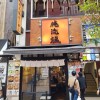 Non-ramen Ramen Restaurant Stars: The quest begins at Tokyo’s Oreryu Shio
Non-ramen Ramen Restaurant Stars: The quest begins at Tokyo’s Oreryu Shio McDonald’s new Happy Meals offer up cute and practical Sanrio lifestyle goods
McDonald’s new Happy Meals offer up cute and practical Sanrio lifestyle goods Limited-edition Carbonara Udon will anger noodle purists and pasta lovers 【Taste test】
Limited-edition Carbonara Udon will anger noodle purists and pasta lovers 【Taste test】 Japanese ramen restaurants under pressure from new yen banknotes
Japanese ramen restaurants under pressure from new yen banknotes All-you-can-drink Starbucks and amazing views part of Tokyo’s new 170 meter-high sky lounge
All-you-can-drink Starbucks and amazing views part of Tokyo’s new 170 meter-high sky lounge French Fries Bread in Tokyo’s Shibuya becomes a hit on social media
French Fries Bread in Tokyo’s Shibuya becomes a hit on social media Studio Ghibli releases new action figures featuring Nausicaä of the Valley of the Wind characters
Studio Ghibli releases new action figures featuring Nausicaä of the Valley of the Wind characters New private rooms on Tokaido Shinkansen change the way we travel from Tokyo to Kyoto
New private rooms on Tokaido Shinkansen change the way we travel from Tokyo to Kyoto Studio Ghibli glasses cases let anime characters keep an eye on your spectacles
Studio Ghibli glasses cases let anime characters keep an eye on your spectacles Beautiful Ghibli sealing wax kits let you create accessories and elegant letter decorations【Pics】
Beautiful Ghibli sealing wax kits let you create accessories and elegant letter decorations【Pics】 Studio Ghibli releases Kiki’s Delivery Service chocolate cake pouches in Japan
Studio Ghibli releases Kiki’s Delivery Service chocolate cake pouches in Japan New definition of “Japanese whiskey” goes into effect to prevent fakes from fooling overseas buyers
New definition of “Japanese whiskey” goes into effect to prevent fakes from fooling overseas buyers Our Japanese reporter visits Costco in the U.S., finds super American and very Japanese things
Our Japanese reporter visits Costco in the U.S., finds super American and very Japanese things Studio Ghibli unveils Mother’s Day gift set that captures the love in My Neighbour Totoro
Studio Ghibli unveils Mother’s Day gift set that captures the love in My Neighbour Totoro New Japanese KitKat flavour stars Sanrio characters, including Hello Kitty
New Japanese KitKat flavour stars Sanrio characters, including Hello Kitty More foreign tourists than ever before in history visited Japan last month
More foreign tourists than ever before in history visited Japan last month New Pokémon cakes let you eat your way through Pikachu and all the Eevee evolutions
New Pokémon cakes let you eat your way through Pikachu and all the Eevee evolutions Sales of Japan’s most convenient train ticket/shopping payment cards suspended indefinitely
Sales of Japan’s most convenient train ticket/shopping payment cards suspended indefinitely Sold-out Studio Ghibli desktop humidifiers are back so Totoro can help you through the dry season
Sold-out Studio Ghibli desktop humidifiers are back so Totoro can help you through the dry season Japanese government to make first change to romanization spelling rules since the 1950s
Japanese government to make first change to romanization spelling rules since the 1950s Ghibli founders Toshio Suzuki and Hayao Miyazaki contribute to Japanese whisky Totoro label design
Ghibli founders Toshio Suzuki and Hayao Miyazaki contribute to Japanese whisky Totoro label design Doraemon found buried at sea as scene from 1993 anime becomes real life【Photos】
Doraemon found buried at sea as scene from 1993 anime becomes real life【Photos】 Tokyo’s most famous Starbucks is closed
Tokyo’s most famous Starbucks is closed One Piece characters’ nationalities revealed, but fans have mixed opinions
One Piece characters’ nationalities revealed, but fans have mixed opinions We asked a Uniqlo employee what four things we should buy and their suggestions didn’t disappoint
We asked a Uniqlo employee what four things we should buy and their suggestions didn’t disappoint Princesses, fruits, and blacksmiths: Study reveals the 30 most unusual family names in Japan
Princesses, fruits, and blacksmiths: Study reveals the 30 most unusual family names in Japan Watch Kanto’s Strongest Italian Chef transform McDonald’s into fine cuisine!【Recipe】
Watch Kanto’s Strongest Italian Chef transform McDonald’s into fine cuisine!【Recipe】 McDonald’s new toppings yield a cheap surprise: Hidden Chicken Crisp for 140 yen!
McDonald’s new toppings yield a cheap surprise: Hidden Chicken Crisp for 140 yen! McDonald’s Japan to give new burgers away for free—provided you have the right name
McDonald’s Japan to give new burgers away for free—provided you have the right name Sliders come to Japanese fast food chain Lotteria, so of course we try them! [Pics]
Sliders come to Japanese fast food chain Lotteria, so of course we try them! [Pics] Is Burger King’s Big Mouth Burger really as overwhelmingly meaty as promised? 【Taste test】
Is Burger King’s Big Mouth Burger really as overwhelmingly meaty as promised? 【Taste test】 Trying out First Kitchen’s tsukimi mochi burgers for a taste of Japanese autumn
Trying out First Kitchen’s tsukimi mochi burgers for a taste of Japanese autumn Tokyo’s new burger chain isn’t new, is disappointing, tasty, and hopeful all at once【Taste test】
Tokyo’s new burger chain isn’t new, is disappointing, tasty, and hopeful all at once【Taste test】 All-you-can-eat cheeseburgers offered by Burger King Japan for its 1,495-calorie King Yeti burger
All-you-can-eat cheeseburgers offered by Burger King Japan for its 1,495-calorie King Yeti burger Burger King Japan offering all-you-can-eat quadruple cheeseburgers
Burger King Japan offering all-you-can-eat quadruple cheeseburgers Sushi vinegar for your McDonald’s hamburger? We create the Japan dip sandwich【Taste test】
Sushi vinegar for your McDonald’s hamburger? We create the Japan dip sandwich【Taste test】 We try Freshness Burger’s latest creation, the Blueberry Cheese Burger【Taste Test】
We try Freshness Burger’s latest creation, the Blueberry Cheese Burger【Taste Test】 We try McDonald’s Japan’s new, as-yet-unnamed, Hokkaido hot potato burger
We try McDonald’s Japan’s new, as-yet-unnamed, Hokkaido hot potato burger KFC releases the Zinger Triple Down in Korea 【Taste Test】
KFC releases the Zinger Triple Down in Korea 【Taste Test】 Burger King releases a “TOP” Burger in Japan
Burger King releases a “TOP” Burger in Japan Mos Burger’s new Mac and Cheese burger: Does it taste as good as it looks?
Mos Burger’s new Mac and Cheese burger: Does it taste as good as it looks? Domino’s Pizza Japan creates abomination out of 2.2 pounds of cheese, we order one immediately
Domino’s Pizza Japan creates abomination out of 2.2 pounds of cheese, we order one immediately
Leave a Reply